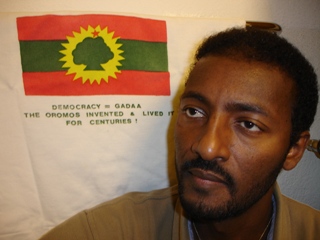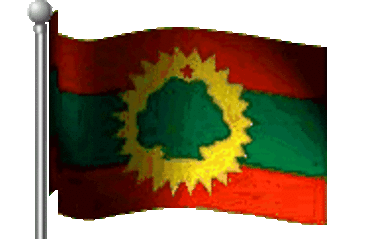There may not be a country called Ethiopia after Melese
By Magn Nyang
There was no country called Ethiopia before Minelik’s rule. In fact, the word “Ethiopia” came from Greek, meaning “burned faces.” “Ethio” means burned and “pia” means faces.
Passing through the North, the Arab part of Africa, Europeans saw people with burned faces, meaning dark face people, living below Sahara desert. There fore, they referred to every one that was living below Sahara desert as “Ethiopian.” Today’s Ethiopia inhabitants were among the “burned face” people they referred to. In this land, so called Ethiopia today, there were ethnic groups who lived independently from each other. While the Oromo people lived in the East, the central, and the West, the Anuak and the Amahara people lived in the West and the North respectively. However, when Minelik came to power, he invaded Oromo’s, Anuak’s, Gurage’s and every other non-Amhara land. After the invasion, Minelik combined what was called Abyssinia with the new territories and named them “Ethiopia.” The irony part was that a man, who had claimed to have been a descendent of king Solomon of Israel, would take upon him a name that was meant for all” dark faced people” living below Sahara desert. Any how, Minelik consolidated his power over those territories and ruled for years before passing the throne to his cousin Haile Selessie.
Emperor Haile Selessie followed his cousin’s foot steps by only collecting taxes from the new territories, not wanting to have anything to do with the inhabitants of those territories. Both Minelik and Haile Selessie were more interested in the new territories’ wealth than the people in those territories. Then, came their distant cousin by the name of Mangistu Haile Mariam. Mangistu was a nationalist, who loved his country so much that he lost focus on how to lead. He was more of a country lover than a leader or a politician.
Out of his love for his country; Mangistu even went out of his way to educate the forgotten tribes. He built roads, schools, and hospitals for those who where forgotten or ignored by his predecessors. Mangistu failed to recognize the fact that so called “Ethiopia” was artificially manufactured by Minelik and Haile Selessie (in the Eritrea case). He led with an iron fist, trying to hold together a country that was not meant to stay united. Mengistu learned his lesson the hard way in May 1991. He fled the country and a year later, Eritrea became an independent country.
Back in Addis, the new guys in town were led by a college dropout named Legasse/Meles Zenawi. Up on its arrival in Addis, the EPDRF, led by Meles announced that it came to liberate the oppressed. As the chairman of the EPDRF, Meles promised the oppressed two years of transition governance. However, Meles still is the president of Ethiopia fourteen years after the promise. In the last fourteen years, we came to see Meles’ true color. Meles used imprisonment and mass murder to intimidate his opponents and to stay in power.
Let me now discuss Meles’ regime differences from his predecessors.
While Minelik and Haile Selassie were feudalists, Mengistu was a socialist. The former two led a very centralized governments that benefited only their own families and their own tribesmen by large. There is not much to say about these two, for they did not leave any historical significance as far as I am concerned. On the other hand, Mengistu reached out to the ignored and the forgotten people. Being the nationalist that he was, Mengistu was determined to keep the country unified with one strong central government. He forced the majority and the minority, the privileged and the under privileged, and the rulers and the ruled to stay united. This mistake (forcing an artificial unification on different ethnic groups without first ensuring their equality) led to his demise. Having said all of these, Mengistu deserved some credits for expending hospitals (clinic) services and education opportunities to the forgotten people.
Unlike his predecessors, Meles is a very intelligent politician. He knows how to manipulate things to his advantage. His major difference from his three predecessors is his introduction of article 39. According to this article every nation, nationality and people in Ethiopia has an unconditional right to self-determination, including the right to secession. In doing so, Meles became the first leader in Ethiopia’s history to introduce such an article in the constitution and he deserves some credit to his name.
However, as we all witness in the last fourteen years, article 39 turnout to be just a symbol on the constitution papers. It was not put to practice. Meles does not only stop the regions from running their own affairs, he also hand picks the leaders. For example, in the last three elections, Gambellian voted and elected independent candidates. However, Meles rejected all three and handpicked his own stooges to become regional governors. According to him, only candidates that are connected to EPDRF are fit to lead.
There are few positive things worth mentioning about Meles’ regime when it comes to minorities. Even though, Meles handpicks regional governors (in Gambella case), his picks are all from local ethnic groups. His predecessors did not bother to pick from local ethnic groups. They considered non-Northern to be inferiors and therefore, incapable of leading themselves. They always sent one of their own from the North to lead non-Northern.
Meles also allowed regional schools to teach local languages to their children. Today, unlike me, all my younger brothers and sisters can read and write in Anuak. For somebody like me, who grew up during Mengistu’s regime, reading and writing in Anuak was just a day dream. In pre-Meles Ethiopia, Amharic language and culture was imposed on all Ethiopians. In fact, to be considered pure Ethiopian, one must not only speak Amharic, but also has to change his/her name to an Amhara name (some of my Oromo friends will testify to this). I remember riding a taxi or a bus in Addis Ababa during Mengistu and not even a day have I heard Oromenya been spoken in taxis or buses. How ever, as soon as Meles’ forces took over Addis Ababa, Oromenya resurfaced and I started hearing Oromenya in taxis or buses. That was due to what I would like to call “freedom of languages” implemented by Meles’ regime early on.
Regardless of the things I said above, I am not anti-one national language. After all, every successful country has one national language. I only said what I said to just emphasized how pre-Meles regimes repressed other languages in favor of Amharic. Other countries such as Kenya did not repress other languages in favor of the national language. Every tribe was allowed to speak its own language freely and yet Kenyans have one national language.
My recommendations for the survival of Ethiopia.
As we all read in the compression part of this article, both Mengistu and Meles have done few good things for Ethiopians as a whole, not for just the privileged. There fore, it is only natural for the next leader to do better than these two. Bellow, are my recommendations:
In the next Ethiopia, ultimate governing authority must be divided between the national government and regional governments. In other word, article 39 must be put to practice.
The regions must be protected constitutionally from unwarranted interference in their local affairs. The national government needs to only take responsibility for establishing a strong defense and promote a sound economy, while the regions retain all other governing functions, including oversight of public morals (social services), and safety.
Tyranny of the majority (the potential of a majority to monopolize power for its own gain and to the detriment of minority rights and interests) must cease and last, but not the least,
The next Ethiopian government must make peace with Eritrea. Any future leader of Ethiopia must come to realization that the wellbeing of Ethiopia depends on peace with its neighbors, including Eritrea. There are political parties, including the CUD, that are already beating the drums of war with Eritrea to reclaim Aseb’s port by force. My advice to any political party that wants to go to war with Eritrea over a port is that, you pick a fight; you fight it alone. We the Gambellians, and I am also sure, the Oromo people, will no longer be deceived to take part in any fighting with Eritrea. Any attempt to regain the use of Aseb’s port by next Ethiopian government must be carried out only by brotherly negotiations with our Eritrean brothers. Let us not forget that before 1998 war between the two countries, Ethiopia had full access to Aseb’s port with the blessing of Eritrean government. There fore, I don’t see any reason that will prevent the two countries from going back to pre-1998 relationship once we get rid of Meles’ regime.
In conclusion, I would like to say that any thing less than the above recommendations will be a recipe for a disaster. If the next Ethiopian regime is going to be like the previous ones, with a centralized power in Addis Ababa, groups (GPLM/A, OLF) that are waging armed struggle now to get rid of Meles’ regime are not going to be part of it. These groups are fighting against centralization and for self-determination. There fore, for the sake of keeping Ethiopia intact (keeping it from being split into pieces), the next regime should have a decentralized government. Otherwise, this country called Ethiopia, will be split into small countries and some one, I don’t know who yet, will take the blame.
The writer can be contacted by writing to magnnyang@yahoo.com



0 Comments:
Post a Comment
<< Home